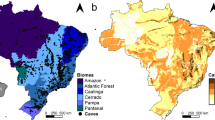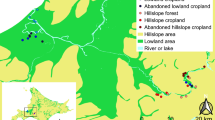Abstract
In 2005, the non-native Nylanderia flavipes was first recorded from Ohio. Here, we present the results of a baseline study designed to assess the status of this exotic species in northeastern Ohio and to explore its potential impacts on local ant communities and the extent to which it has been incorporated into the diet of a native predator, the red-backed salamander. At the sites where N. flavipes occurred, we found a sixfold increase in total ant abundance, with 87% of all ants collected being N. flavipes. The high numerical dominance of N. flavipes did not lead to observable changes in the species richness and abundance of the native ant community. At baits, N. flavipes did not engage in interspecific combat and did not exhibit aggression towards native ants. Thus, aggression and interference competition are not likely factors explaining the high local abundance of N. flavipes. Red-backed salamanders have incorporated N. flavipes into their diet, but further research is needed to understand the interactions of N. flavipes within the forest-floor food web. Although we did not detect changes in the local ant communities in the presence of N. flavipes, we argue that this species’ high local abundance and ability to forage at cooler temperatures may give it a competitive advantage and thereby affect native ants through exploitative competition.
Similar content being viewed by others
References
Andersen AN (1995) A classification of Australian ant communities, based on functional groups which parallel plant life-forms in relation to stress and disturbance. J Biogeogr 22:15–29
Davic RD, Welsh HH Jr (2004) On the ecological role of salamanders. Ann Rev Ecol Evol Syst 35:405–434
Debout G, Schatz B, Elias M, McKey D (2007) Polydomy in ants: what we know, what we think we know, and what remains to be done. Biol J Linn Soc 90:319–348
Fisher BF, Cover SP (2007) Ants of North America–a guide to the genera. University of California Press, Berkeley pp 194
Fraser DF (1976) Empirical evaluation of the hypothesis of food competition in salamanders of the genus Plethodon. Ecology 57:459–471
Guénard B, Dunn RR (2010) A new (old) invasive ant in the hardwood forests of eastern North America and its potentially widespread impacts. PlosOne 5:e11614
Holway DA (1998) Effect of Argentine ant invasions on ground-dwelling arthropods in northern California riparian woodlands. Oecologia 116:252–258
Holway DA, Lach L, Suarez AV, Tsutsui ND, Case TJ (2002) The causes and consequences of ant invasions. Ann Rev Ecol Syst 33:181–233
Ichinose K (1986) Occurrence of polydomy in a monogynous ant, Paratrechina flavipes (Hymenoptera: Formicidae). Kontyû 54:208–217
Ivanov K, Milligan J (2008) Paratrechina flavipes (Smith) (Hymenoptera: Formicidae) a new exotic ant for Ohio. Proc Entomol Soc Wash 110:439–444
Jaeger RG, Barnard DE (1981) Foraging tactics of a terrestrial salamander: Choice of diet in structurally simple environments. Am Nat 117:639–664
King JR, Tschinkel WR (2006) Experimental evidence that the introduced fire ant, Solenopsis invicta, does not competitively suppress co-occurring ants in a disturbed habitat. J Anim Ecol 75:1370–1378
LaPolla JS, Brady SG, Shattuck SO (2010) Phylogeny and taxonomy of the Prenolepis genus-group of ants (Hymenoptera: Formicidae). Syst Entomol 35:118–131
Lowe S, Browne M, Boudjelas S, De Poorter M (2000) 100 of the World’s Worst Invasive Alien Species: a selection from the global invasive species database. Invasive Species Specialist Group, Gland, Switzerland, pp 12
Maerz JC, Karuzas JM, Madison DM, Blossey B (2005) Introduced invertebrates are important prey for a generalist predator. Diversity Distrib 11:83–90
Maerz JC, Nuzzo VA, Blossey B (2009) Declines in woodland salamander abundance associated with non-native earthworm and plant invasions. Conserv Biol 23:975–981
McGlynn TP (1999a) The worldwide transfer of ants: geographical distribution and ecological invasions. J Biogeogr 26:535–548
McGlynn TP (1999b) Non-native ants are smaller than related native ants. Am Nat 154:690–699
Meyers JM (2008) Identification, distribution and control of an invasive pest ant, Paratrechina sp. (Hymenoptera: Formicidae), in Texas. Dissertation, Texas A&M University, pp 163
Pećarevic M, Danoff-Burg J, Dunn RR (2010) Biodiversity on Broadway–enigmatic diversity of the societies of ants (Formicidae) on the streets of New York City. PlosOne 5:e13222
Petranka JW (1998) Salamanders of the United States and Canada. Smithsonian Institution Press, Washington DC, pp 587
Porter SD, Savignano DA (1990) Invasion of polygyne fire ants decimate native ants and disrupts arthropod community. Ecology 71:2095–2106
Suarez AV, Case TJ (2002) Bottom-up effects on persistence of a specialist predator: ant invasions and horned lizards. Ecol Appl 12:291–298
Suarez AV, Bolger DT, Case TJ (1998) Effects of fragmentation and invasion on native ant communities in coastal southern California. Ecology 79:2041–2056
Todd BD, Rothermel BB, Reed RN, Luhring TM, Schlatter K, Trenkamp L, Gibbons JW (2008) Habitat alteration increases invasive fire ant abundance to the detriment of amphibians and reptiles. Biol Invasions 10:539–546
Trager JC (1984) A revision of the genus Paratrechina (Hymenoptera: Formicidae) of the continental United States. Sociobiology 9:49–162
Tschinkel WR (1988) Distribution of the fire ants Solenopsis invicta and S. geminata (Hymenoptera: Formicidae) in northern Florida in relation to habitat and disturbance. Ann Entomol Soc Am 81:76–81
Tsutsui ND, Suarez AV (2003) The colony structure and population biology of invasive ants. Conserv Biol 17:28–58
Uno S, Cotton J, Philpott SM (2010) Diversity, abundance, and species composition of ants in urban green spaces. Urban Ecosyst 13:425–441
Walton BM, Tsatiris D, Rivera-Sostre M (2006) Salamanders in forest-floor food webs: invertebrate species composition influences top-down effects. Pedobiologia 50:313–321
Acknowledgments
We thank the Shaker Lakes Nature Center and the Cleveland Metroparks for access to the study sites and permission to collect samples. We also thank J. Milligan, K. Thompson, and R. Gibson for their help with various components of the field work. Comments and suggestions from R. Gibson, J. Milligan, C. Lockhart, N. Sanders and three anonymous reviewers improved the manuscript. This research was partially supported by the Ohio Biological Survey small grants program.
Author information
Authors and Affiliations
Corresponding author
Electronic supplementary material
Below is the link to the electronic supplementary material.
Rights and permissions
About this article
Cite this article
Ivanov, K., Lockhart, O.M., Keiper, J. et al. Status of the exotic ant Nylanderia flavipes (Hymenoptera: Formicidae) in northeastern Ohio. Biol Invasions 13, 1945–1950 (2011). https://doi.org/10.1007/s10530-011-0021-z
Received:
Accepted:
Published:
Issue Date:
DOI: https://doi.org/10.1007/s10530-011-0021-z




